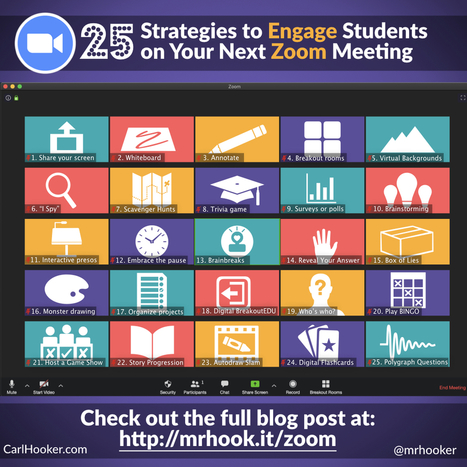
|
Rescooped by Yael Even-Levy, PhD (Second Life: JoelleYalin) from iGeneration - 21st Century Education (Pedagogy & Digital Innovation) |
Research and publish the best content.
Get Started for FREE
Sign up with Facebook Sign up with X
I don't have a Facebook or a X account
Already have an account: Login
Practical approaches & best practices in using cutting-edge learning technologies & design that is relevant to learning professionals & educators. You are most welcome to contribute relevant ideas, or links to your blog, published articles & books, or invitations to your public learning events.
 Your new post is loading... Your new post is loading...
 Your new post is loading... Your new post is loading...
Laura Duque's curator insight,
May 16, 2020 2:31 PM
I found these to be fun and very creative to make online sessions less boring, specially for kids. I found the break rooms and background images to be the most interesting, since it would make group work easier
Julian F Calvo's curator insight,
May 21, 2020 3:39 PM
Some of those strategies were new for me and, I think that is fantastic to know all those features of Zoom since they look very useful. However, I might find the whiteboard not so useful since it is difficult to write something on it, but if the idea is to share this whiteboard for activities, there are some other apps we can use with learner where everybody can participate and they are easy to use.
Manuela Bañol Palacio's curator insight,
May 22, 2020 5:26 PM
This bunch of strategies will help teachers to create engaging classes in Zoom. This app or site has currently been the life-saver for most of the teachers, and I can say that it provides a lot of options to use in the class, so that it becomes interesting in some way. Students and teachers can use these strategies to interact in the Zoom class and make it more dynamic.
Sign up to comment

Eli's curator insight,
February 27, 2013 6:10 PM
Engagement is SO critical to learning, retention and productivity 
Isabel zamora's curator insight,
February 25, 2020 7:41 AM
I found this interesting since you as an online teacher need to be creative and these tools help you a lot. Goanimate its an easy tool for creating short animated dialogues making the course fun. There are a lot of things here that can help you to be interactive into the courses.
|
Daniela Valencia Osorio's curator insight,
March 13, 2020 5:12 PM
The truth is that the environment in the classroom is a key aspect that affects students' motivation for better or for worse.
This article provides four useful tips for teachers to create a positive classroom culture. The first one is about being close to our students by shaking hands at the beginning of the day and by asking them how they are feeling. Then we can ask them their expectations about the class and the people around them so as to get to agreements and ground rules that must be followed in class. Additionally, a team atmosphere must be created in order to make learners aware of the importance of having a good relationship with each other during the courses. Finally, if the efforts are not working, the team needs to get to new agreements again. The article is such a helpful element for future teachers to work together with their students to build a positive environment for learning that is full of teamwork and motivation.
Natalia Arias M's curator insight,
March 15, 2020 2:17 PM
And as teachers, we work to create a community where all students feel safe, supported and heard, no matter the dynamics in the room.
Mario Andres Henao's curator insight,
April 12, 2020 2:39 PM
I think it is important to have a good environment in the classroom, fro the students to enjoy the classes and what the teacher is explaining and for the teacher to give a good class, this tips are very useful and allow the teacher to apply strategists to have a good and positive classroom.
|







![Neuroscience Proves Why Your [Nonprofit] Stories Move Supporters To Action @johnhaydon | Best Practices in Instructional Design & Use of Learning Technologies | Scoop.it](https://img.scoop.it/su4vTU3fOS-R7lYs3N89Wzl72eJkfbmt4t8yenImKBVvK0kTmF0xjctABnaLJIm9)





Helpful ideas for educators at all levels to create additional engagement in virtual classes, events, meetings, etc.